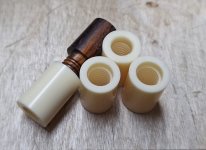Hydex/Isoplast is plenty strong enough for use as a ferrule. It is not far from Tomahawk in terms of tensile strength, and modulus rupture strength, if my memory serves me correctly. Hydex 202/Isoplast does have a miniscule weight advantage over Tomahawk while being a touch "weaker," which is probably a poor choice of words. The difference between the two materials is negligible.FYI, DZ said my request was the first time he'd heard of hydex. Also indicated hydex was so much lighter than Tomahawk that he questioned its strength, durability and resistance to chalk (he meant less dense, not lighter, IMO), and said he might consider adding hydex if he got a sample and could verify its weight (he meant density IMO). Since he added hydex, perhaps someone sent a sample, maybe not. You're not doing yourself any favors, dave.
As with a great deal of these materials, some of the material chosen is application dependent, and some of it just boils down to personal preference. As it stands, both Hydex and Tomahawk are excellent ferrule choices.
